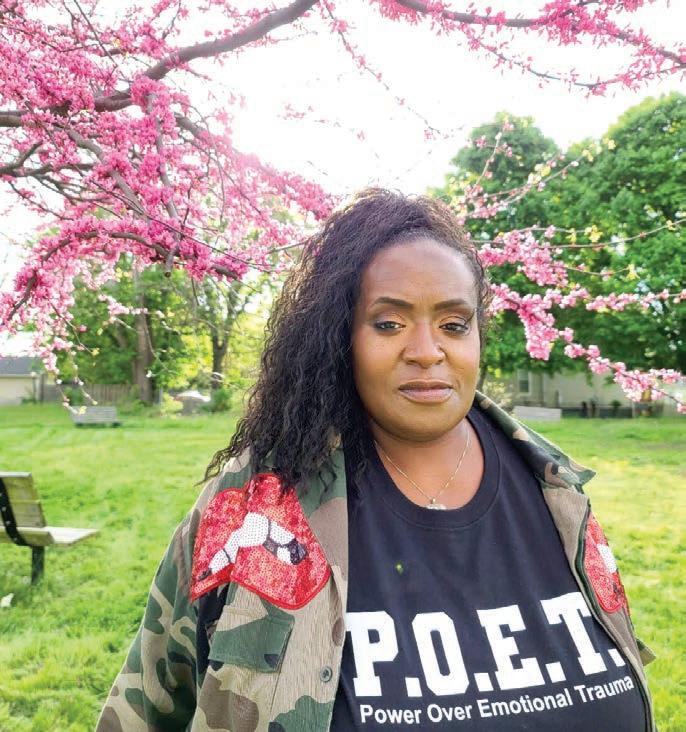FEATURE “BLACK LIVES MATTER IS A TERRORIST ORGANIZATION” The Cleveland police union’s ugly history with BLM By Vince Grzegorek
A
T THE TAIL END OF A conversation in early June hosted by the Cleveland Metropolitan Bar Association between Black Lives Matter Cleveland co-founder Kareem Henton and Joseph Delguyd, an attorney for the Cleveland Police Patrolmen’s Association, the union lawyer offered Henton his cell phone number so the two sides could maintain an open dialogue between activists and police going forward. The gesture came after an hour of mostly civil debate on what the momentous national movement toward police accountability in the wake of the George Floyd protests might mean locally, with Henton arguing that the union’s steadfast and recalcitrant defense of officers accused of misconduct means they’re “complicit in the aggressive police culture that exists,” and Delguyd largely defending recent efforts to reform under the current Consent Decree but acknowledging, “If there is change coming and we can be part of that change, we’d like to be.” A week after, Scene asked Henton to reflect on the conversation. He had three main takeaways. First, that Delguyd was only doing his job as a rep for the union shop. Second, that the union agreed to be part of the conversation at all, and that the lawyer made the longoverdue gesture to open a dialogue, indicates just how powerful the groundswell of support for the Black Lives Matter movement has become. “We go from the inflammatory talk that we would normally get from [Steve] Loomis or [Jeff] Follmer to him saying, ‘I’d love to talk to you.’ That means they’re nervous,” he said. “They’re seeing us for who we really are — as folks that are trying to advocate for necessary change. There’s legitimacy. And folks acknowledge the legitimacy of the protests. That’s a heck of a message.” And third, that the union’s longstanding efforts to defend Timothy Loehmann, among others, shows the CPPA hasn’t strayed far from its origins. “I think about the history of their
14
| clevescene.com | July 1-7, 2020
Sequoia Bostick
inception and this all being business as usual,” he said. That history, Henton noted, is right there on CPPA’s website, though it tells a false story with a string of mostly true sentences. “LIKE MUCH OF THE PROGRESS obtained in policing in America, the Cleveland Police Patrolmen’s Association was born out of the most tragic day in the history of the Cleveland Police Department,” the site says. “On July 23, 1968, in the Glenville Section of the city, rioting militants murdered three of our own, and a fourth officer died years later as result of his injuries inflicted that day. While there was no shortage of valor, courage and relentless spirit among the officers that finally brought calm back to the city that day, there was an obvious shortage of necessary equipment which could have saved the lives of police officers as well as the brave civilians who attempted to save them.” “Under the guidance and assistance of the Boston Police Patrolmen’s Association, the
CPPA was formed in January 1969 and became the labor union for all non-supervisory Patrol Officers. Prior to the formation of our Association, our officers took their chances in Cuyahoga County Common Pleas Court to address any grievances. Through successful labor contracts, work hours, sick and vacation time off, and worker rights quickly replaced blanket mistreatment of patrol officers. Out of the tragedy of the Glenville Riots and due to the loud voices of the survivors who fought that day, street officers were soon issued portable radios which enabled citywide communications. Also, the fist Tactical Unit was formed, which trained and equipped specific officers to respond to especially dangerous situations such as riots and barricaded suspects. This valuable unit later became the modern-day Special Weapons and Tactics Unit, or SWAT.” The formation of the CPPA did come in response to the Glenville riots, and yes, the Boston police union, an outfit long noted for its surpassing
dedication to racial equity, lent its support, but the cops’ grievances weren’t all about radios and sick time. Police reform had topped Carl Stokes’ mayoral campaign promises in 1967, and though he intended to correct a laundry list of problems that beset a police force nagged by corruption and violence, the relationship between the mostly white department and the city’s Black citizens was paramount. “All the police knew that few policeman faced charges or an appearance before the grand jury for shooting a Black man while on duty,” Stokes said. This did not make Stokes many friends in the rank and file, many of whom preferred to unleash violence on Cleveland’s Black population with an immunity they’d grown comfortably accustomed to. And when Glenville erupted, those white officers felt personally and deeply aggrieved when, instead of letting white cops parade through the rioting streets with high-powered rifles, Stokes, after convening a large City Hall meeting of only African-American leaders and officials, sidelined white officers from Glenville, allowing only Black officers and the National Guard to work to restore order. Stokes was also vocally critical of the role he felt Cleveland police had played in the violence, writing in his autobiography later that they had been “self-protective, corrupt and destructive.” “There was tension in the department,” one Black female officer told the Plain Dealer. “The whites wanted to go out there and even things up.” “Tell Stokes to go piss on it. Fuck that n----r mayor,” cops radioed each other, according to a federal report on the aftermath. Fear gripped the city’s mostly white west side; cops openly revolted against the police chief and mayor. Fliers were distributed in white neighborhoods warning that invading rioters were coming for their property, and their bodies. The relationship between Cleveland’s Black community and police was





